Employee Retention: A Case Study of Millennial Workforce Dynamics
VerifiedAdded on 2020/04/13
|11
|2986
|490
Report
AI Summary
This report presents a case study examining the resignation of a millennial employee, Tony, from a multinational company, attributing it to conflicts with senior colleagues, feelings of isolation, and demotivation stemming from negative rumors about his teamwork. The report explores the potential for the organization to retain Tony through training focused on enhancing his communication, adaptability, and interpersonal skills. It highlights the importance of workplace relationships and their impact on employee satisfaction and retention, particularly for millennials who often bring fresh perspectives and technological skills. Furthermore, the study applies Maslow's Hierarchy of Needs to understand Tony's dissatisfaction, specifically his unmet belongingness needs, and how addressing these needs could improve his job satisfaction and overall engagement. The report discusses the benefits and drawbacks of retaining Tony, considering both the advantages of his skills and the potential negative impact on workplace dynamics if he is forced to work in a negative environment. The study also analyzes the application of McGregor's Theory X and Y, which explains Tony's initial motivation and subsequent demotivation due to external factors.

Running head: ACADEMIC WRITING
Millennial in the Multi-Generational workforce
Name of the Student
Name of the University
Author Note
Millennial in the Multi-Generational workforce
Name of the Student
Name of the University
Author Note
Paraphrase This Document
Need a fresh take? Get an instant paraphrase of this document with our AI Paraphraser

1
ACADEMIC WRITING
Table of Contents
Abstract......................................................................................................................................2
Introduction................................................................................................................................3
Discussion..................................................................................................................................5
Conclusion..................................................................................................................................8
References..................................................................................................................................9
ACADEMIC WRITING
Table of Contents
Abstract......................................................................................................................................2
Introduction................................................................................................................................3
Discussion..................................................................................................................................5
Conclusion..................................................................................................................................8
References..................................................................................................................................9

2
ACADEMIC WRITING
Abstract
This report is about a case study of a millennial employee Tony who has given his resignation
in a multinational company where he was working at present. The main reason behind his
resignation has perceived from the case study is his inner conflict dealing with few senior
employees. Moreover, he started feeling isolated and demotivated the moment he gets to hear
that one of his senior employees is spreading rumors that he is not a good team player and
mostly get his work done through technologies. Tony has also changed jobs previously
whenever he found that the company’s working style is not matching with that of his own.
However, the problem of Tony can be solved if this organization does not accept his
resignation, instead retain him, and provide an effective training program through which his
adaptability, communicative and interpersonal skills are enhanced. However, research has
stated that workplace relationships and interaction has an effect on the employee’s
satisfaction and retention. Therefore, retaining a millennial employee, as Tony can be
beneficial for the organization because a millennial employee are not only confident and
enthusiastic but also has fresh and creative ideas that can help in rapid problem solving.
Lastly, Maslow’s theory of motivation has been directly applied to understand the reason
behind Tony’s resignation.
ACADEMIC WRITING
Abstract
This report is about a case study of a millennial employee Tony who has given his resignation
in a multinational company where he was working at present. The main reason behind his
resignation has perceived from the case study is his inner conflict dealing with few senior
employees. Moreover, he started feeling isolated and demotivated the moment he gets to hear
that one of his senior employees is spreading rumors that he is not a good team player and
mostly get his work done through technologies. Tony has also changed jobs previously
whenever he found that the company’s working style is not matching with that of his own.
However, the problem of Tony can be solved if this organization does not accept his
resignation, instead retain him, and provide an effective training program through which his
adaptability, communicative and interpersonal skills are enhanced. However, research has
stated that workplace relationships and interaction has an effect on the employee’s
satisfaction and retention. Therefore, retaining a millennial employee, as Tony can be
beneficial for the organization because a millennial employee are not only confident and
enthusiastic but also has fresh and creative ideas that can help in rapid problem solving.
Lastly, Maslow’s theory of motivation has been directly applied to understand the reason
behind Tony’s resignation.
⊘ This is a preview!⊘
Do you want full access?
Subscribe today to unlock all pages.

Trusted by 1+ million students worldwide
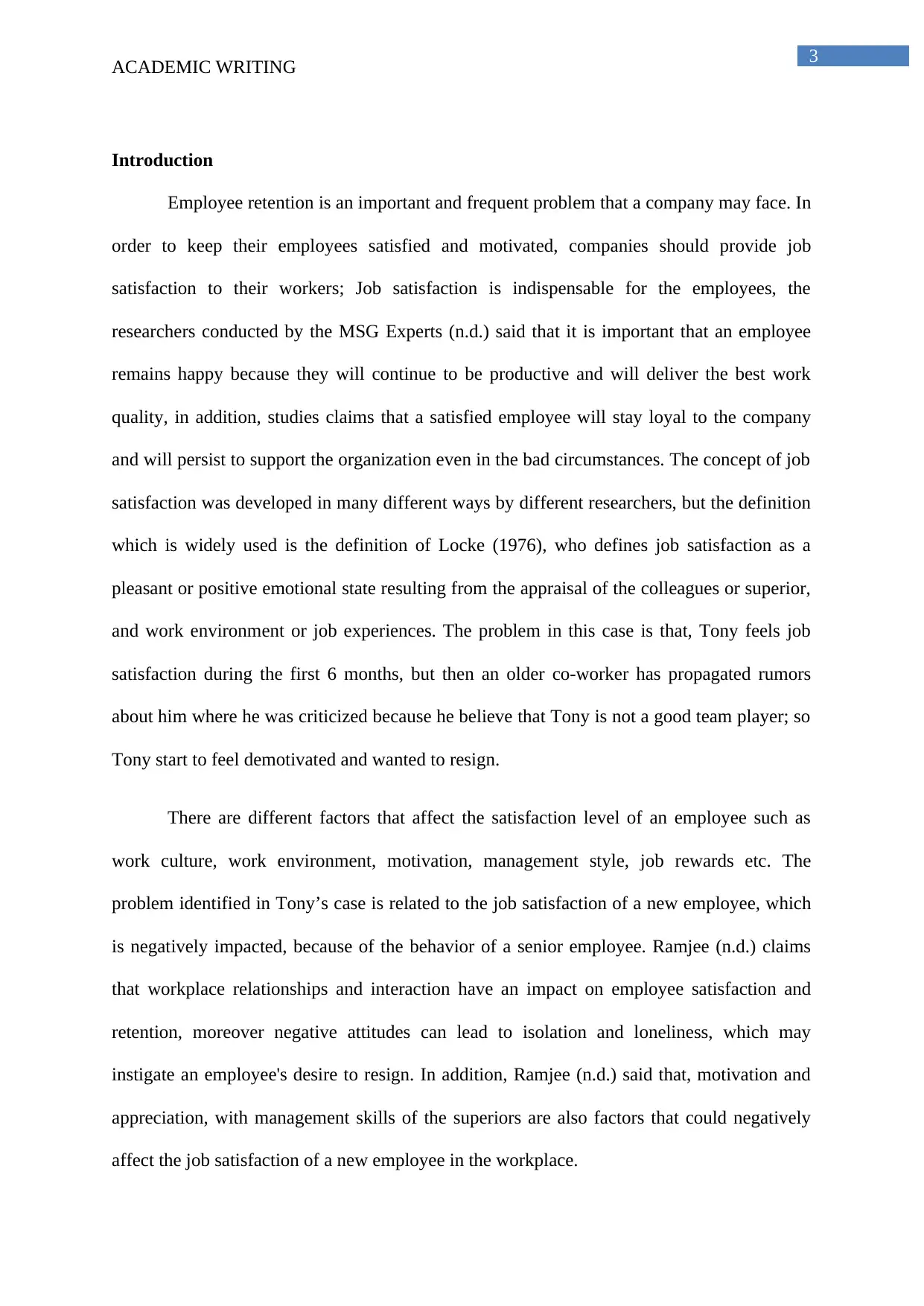
3
ACADEMIC WRITING
Introduction
Employee retention is an important and frequent problem that a company may face. In
order to keep their employees satisfied and motivated, companies should provide job
satisfaction to their workers; Job satisfaction is indispensable for the employees, the
researchers conducted by the MSG Experts (n.d.) said that it is important that an employee
remains happy because they will continue to be productive and will deliver the best work
quality, in addition, studies claims that a satisfied employee will stay loyal to the company
and will persist to support the organization even in the bad circumstances. The concept of job
satisfaction was developed in many different ways by different researchers, but the definition
which is widely used is the definition of Locke (1976), who defines job satisfaction as a
pleasant or positive emotional state resulting from the appraisal of the colleagues or superior,
and work environment or job experiences. The problem in this case is that, Tony feels job
satisfaction during the first 6 months, but then an older co-worker has propagated rumors
about him where he was criticized because he believe that Tony is not a good team player; so
Tony start to feel demotivated and wanted to resign.
There are different factors that affect the satisfaction level of an employee such as
work culture, work environment, motivation, management style, job rewards etc. The
problem identified in Tony’s case is related to the job satisfaction of a new employee, which
is negatively impacted, because of the behavior of a senior employee. Ramjee (n.d.) claims
that workplace relationships and interaction have an impact on employee satisfaction and
retention, moreover negative attitudes can lead to isolation and loneliness, which may
instigate an employee's desire to resign. In addition, Ramjee (n.d.) said that, motivation and
appreciation, with management skills of the superiors are also factors that could negatively
affect the job satisfaction of a new employee in the workplace.
ACADEMIC WRITING
Introduction
Employee retention is an important and frequent problem that a company may face. In
order to keep their employees satisfied and motivated, companies should provide job
satisfaction to their workers; Job satisfaction is indispensable for the employees, the
researchers conducted by the MSG Experts (n.d.) said that it is important that an employee
remains happy because they will continue to be productive and will deliver the best work
quality, in addition, studies claims that a satisfied employee will stay loyal to the company
and will persist to support the organization even in the bad circumstances. The concept of job
satisfaction was developed in many different ways by different researchers, but the definition
which is widely used is the definition of Locke (1976), who defines job satisfaction as a
pleasant or positive emotional state resulting from the appraisal of the colleagues or superior,
and work environment or job experiences. The problem in this case is that, Tony feels job
satisfaction during the first 6 months, but then an older co-worker has propagated rumors
about him where he was criticized because he believe that Tony is not a good team player; so
Tony start to feel demotivated and wanted to resign.
There are different factors that affect the satisfaction level of an employee such as
work culture, work environment, motivation, management style, job rewards etc. The
problem identified in Tony’s case is related to the job satisfaction of a new employee, which
is negatively impacted, because of the behavior of a senior employee. Ramjee (n.d.) claims
that workplace relationships and interaction have an impact on employee satisfaction and
retention, moreover negative attitudes can lead to isolation and loneliness, which may
instigate an employee's desire to resign. In addition, Ramjee (n.d.) said that, motivation and
appreciation, with management skills of the superiors are also factors that could negatively
affect the job satisfaction of a new employee in the workplace.
Paraphrase This Document
Need a fresh take? Get an instant paraphrase of this document with our AI Paraphraser
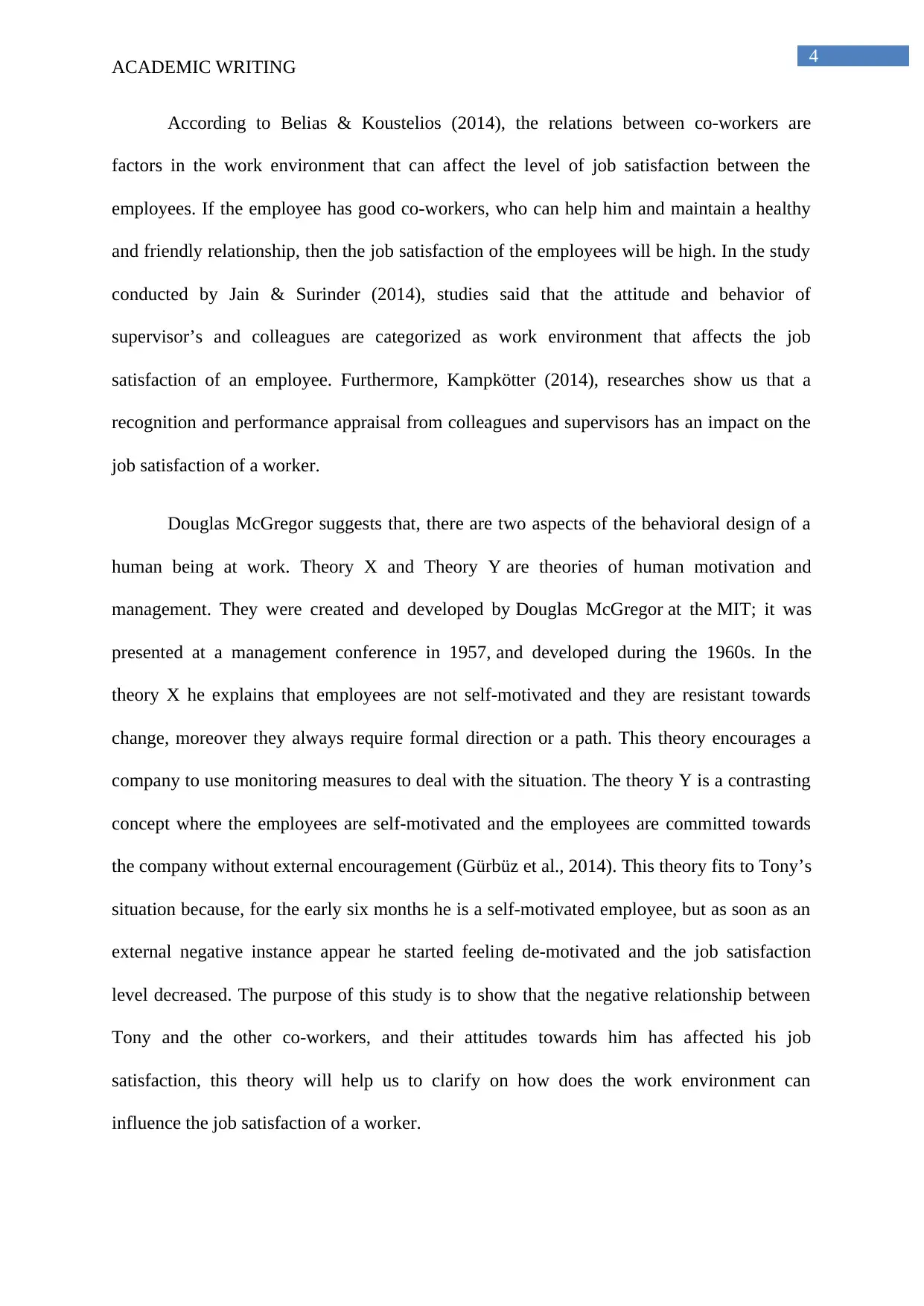
4
ACADEMIC WRITING
According to Belias & Koustelios (2014), the relations between co-workers are
factors in the work environment that can affect the level of job satisfaction between the
employees. If the employee has good co-workers, who can help him and maintain a healthy
and friendly relationship, then the job satisfaction of the employees will be high. In the study
conducted by Jain & Surinder (2014), studies said that the attitude and behavior of
supervisor’s and colleagues are categorized as work environment that affects the job
satisfaction of an employee. Furthermore, Kampkötter (2014), researches show us that a
recognition and performance appraisal from colleagues and supervisors has an impact on the
job satisfaction of a worker.
Douglas McGregor suggests that, there are two aspects of the behavioral design of a
human being at work. Theory X and Theory Y are theories of human motivation and
management. They were created and developed by Douglas McGregor at the MIT; it was
presented at a management conference in 1957, and developed during the 1960s. In the
theory X he explains that employees are not self-motivated and they are resistant towards
change, moreover they always require formal direction or a path. This theory encourages a
company to use monitoring measures to deal with the situation. The theory Y is a contrasting
concept where the employees are self-motivated and the employees are committed towards
the company without external encouragement (Gürbüz et al., 2014). This theory fits to Tony’s
situation because, for the early six months he is a self-motivated employee, but as soon as an
external negative instance appear he started feeling de-motivated and the job satisfaction
level decreased. The purpose of this study is to show that the negative relationship between
Tony and the other co-workers, and their attitudes towards him has affected his job
satisfaction, this theory will help us to clarify on how does the work environment can
influence the job satisfaction of a worker.
ACADEMIC WRITING
According to Belias & Koustelios (2014), the relations between co-workers are
factors in the work environment that can affect the level of job satisfaction between the
employees. If the employee has good co-workers, who can help him and maintain a healthy
and friendly relationship, then the job satisfaction of the employees will be high. In the study
conducted by Jain & Surinder (2014), studies said that the attitude and behavior of
supervisor’s and colleagues are categorized as work environment that affects the job
satisfaction of an employee. Furthermore, Kampkötter (2014), researches show us that a
recognition and performance appraisal from colleagues and supervisors has an impact on the
job satisfaction of a worker.
Douglas McGregor suggests that, there are two aspects of the behavioral design of a
human being at work. Theory X and Theory Y are theories of human motivation and
management. They were created and developed by Douglas McGregor at the MIT; it was
presented at a management conference in 1957, and developed during the 1960s. In the
theory X he explains that employees are not self-motivated and they are resistant towards
change, moreover they always require formal direction or a path. This theory encourages a
company to use monitoring measures to deal with the situation. The theory Y is a contrasting
concept where the employees are self-motivated and the employees are committed towards
the company without external encouragement (Gürbüz et al., 2014). This theory fits to Tony’s
situation because, for the early six months he is a self-motivated employee, but as soon as an
external negative instance appear he started feeling de-motivated and the job satisfaction
level decreased. The purpose of this study is to show that the negative relationship between
Tony and the other co-workers, and their attitudes towards him has affected his job
satisfaction, this theory will help us to clarify on how does the work environment can
influence the job satisfaction of a worker.
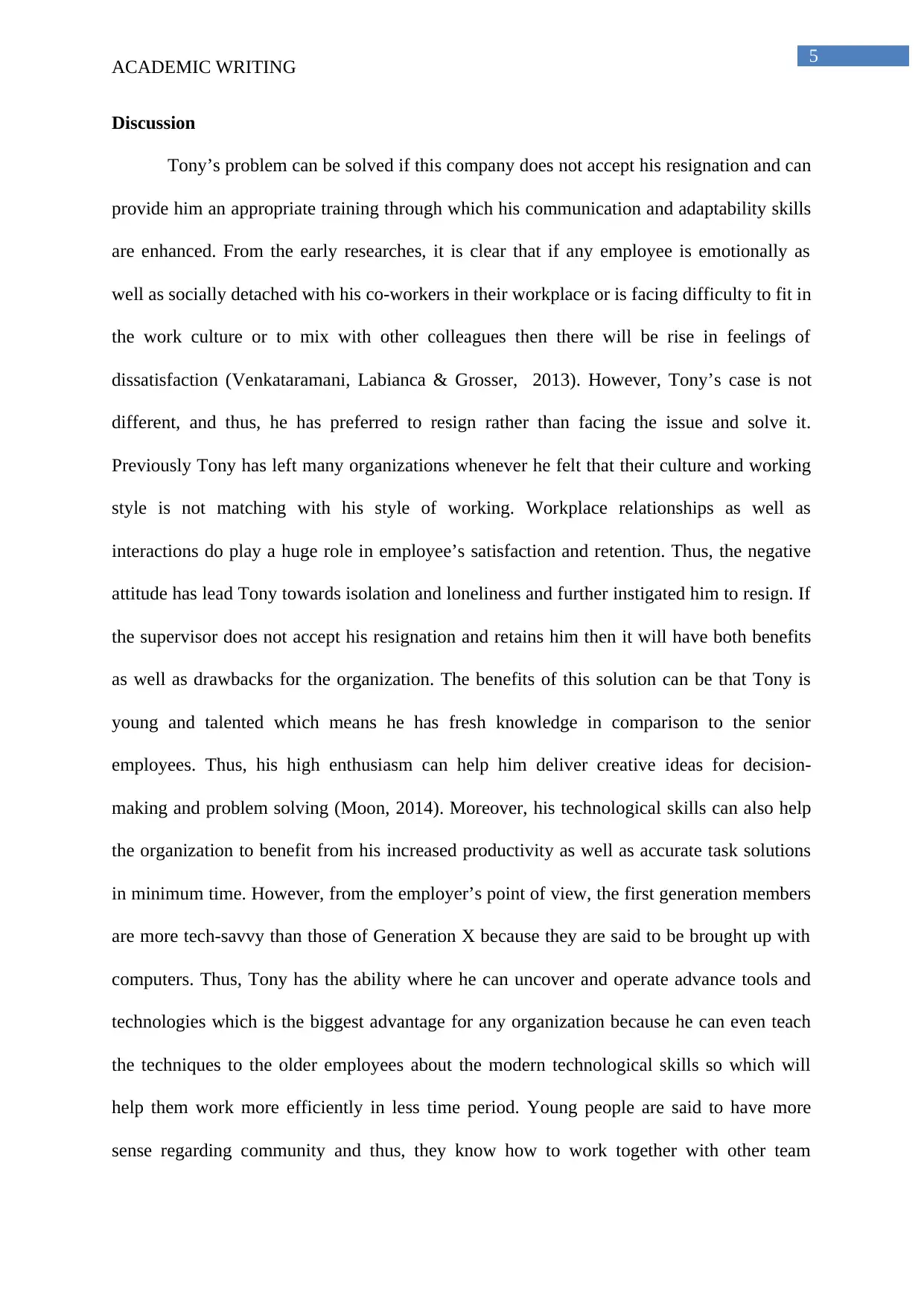
5
ACADEMIC WRITING
Discussion
Tony’s problem can be solved if this company does not accept his resignation and can
provide him an appropriate training through which his communication and adaptability skills
are enhanced. From the early researches, it is clear that if any employee is emotionally as
well as socially detached with his co-workers in their workplace or is facing difficulty to fit in
the work culture or to mix with other colleagues then there will be rise in feelings of
dissatisfaction (Venkataramani, Labianca & Grosser, 2013). However, Tony’s case is not
different, and thus, he has preferred to resign rather than facing the issue and solve it.
Previously Tony has left many organizations whenever he felt that their culture and working
style is not matching with his style of working. Workplace relationships as well as
interactions do play a huge role in employee’s satisfaction and retention. Thus, the negative
attitude has lead Tony towards isolation and loneliness and further instigated him to resign. If
the supervisor does not accept his resignation and retains him then it will have both benefits
as well as drawbacks for the organization. The benefits of this solution can be that Tony is
young and talented which means he has fresh knowledge in comparison to the senior
employees. Thus, his high enthusiasm can help him deliver creative ideas for decision-
making and problem solving (Moon, 2014). Moreover, his technological skills can also help
the organization to benefit from his increased productivity as well as accurate task solutions
in minimum time. However, from the employer’s point of view, the first generation members
are more tech-savvy than those of Generation X because they are said to be brought up with
computers. Thus, Tony has the ability where he can uncover and operate advance tools and
technologies which is the biggest advantage for any organization because he can even teach
the techniques to the older employees about the modern technological skills so which will
help them work more efficiently in less time period. Young people are said to have more
sense regarding community and thus, they know how to work together with other team
ACADEMIC WRITING
Discussion
Tony’s problem can be solved if this company does not accept his resignation and can
provide him an appropriate training through which his communication and adaptability skills
are enhanced. From the early researches, it is clear that if any employee is emotionally as
well as socially detached with his co-workers in their workplace or is facing difficulty to fit in
the work culture or to mix with other colleagues then there will be rise in feelings of
dissatisfaction (Venkataramani, Labianca & Grosser, 2013). However, Tony’s case is not
different, and thus, he has preferred to resign rather than facing the issue and solve it.
Previously Tony has left many organizations whenever he felt that their culture and working
style is not matching with his style of working. Workplace relationships as well as
interactions do play a huge role in employee’s satisfaction and retention. Thus, the negative
attitude has lead Tony towards isolation and loneliness and further instigated him to resign. If
the supervisor does not accept his resignation and retains him then it will have both benefits
as well as drawbacks for the organization. The benefits of this solution can be that Tony is
young and talented which means he has fresh knowledge in comparison to the senior
employees. Thus, his high enthusiasm can help him deliver creative ideas for decision-
making and problem solving (Moon, 2014). Moreover, his technological skills can also help
the organization to benefit from his increased productivity as well as accurate task solutions
in minimum time. However, from the employer’s point of view, the first generation members
are more tech-savvy than those of Generation X because they are said to be brought up with
computers. Thus, Tony has the ability where he can uncover and operate advance tools and
technologies which is the biggest advantage for any organization because he can even teach
the techniques to the older employees about the modern technological skills so which will
help them work more efficiently in less time period. Young people are said to have more
sense regarding community and thus, they know how to work together with other team
⊘ This is a preview!⊘
Do you want full access?
Subscribe today to unlock all pages.

Trusted by 1+ million students worldwide

6
ACADEMIC WRITING
members than in comparison to Generation X people who are more self-centered (Huyler et
al., 2015). Therefore, retaining young employees like Tony can enhance teamwork and
innovation in the organization.
On the other hand, there are few disadvantages as well which the organization will
have to bear if they retain Tony. From the employee’s point of view, it can be said that there
are many employees of Tony who does not want to work with him or who already dislikes
him, so if they are forced to work with Tony after his retention then they might develop a
negative feeling towards the supervisor as well as the organization. Therefore, this can have
an impact on the overall productivity of the employees (Hong et al., 2012). However, as
observed that Tony has become demotivated and unsatisfied in this environment thus, this
will hinder from delivering the best quality work to the organization. Thus, forcing Tony to
work in a negative environment with emotional distress will not only destroy his
concentration power but also can affect his mental as well as physical health. Therefore, his
productivity will get severely affected. However, from the employer’s perspective retaining
Tony means extra expenditure on the company’s part, as they have to arrange a training
programme so that Tony can master his communicative, interpersonal as well as adaptability
skills. Thus, the organization needs to invest in time as well as resources. This training will
however, decrease his hours of productivity in the office as he has to keep his focus on the
training. This will thoroughly teach him how he can keep informal and good relationships
with his co-workers through his social skills and empathy so that he can work in teams
effectively and give as well as receive feedbacks (Langan, 2012).
Maslow’s Hierarchy of Needs can help understand Tony’s reasons of being
demotivated and the reason behind his resignation in this organization. Maslow theory is
mainly a motivational theory, which involves a five-tier model of the needs of individuals,
which is mainly designed in hierarchical levels in a pyramid. Maslow through his theory has
ACADEMIC WRITING
members than in comparison to Generation X people who are more self-centered (Huyler et
al., 2015). Therefore, retaining young employees like Tony can enhance teamwork and
innovation in the organization.
On the other hand, there are few disadvantages as well which the organization will
have to bear if they retain Tony. From the employee’s point of view, it can be said that there
are many employees of Tony who does not want to work with him or who already dislikes
him, so if they are forced to work with Tony after his retention then they might develop a
negative feeling towards the supervisor as well as the organization. Therefore, this can have
an impact on the overall productivity of the employees (Hong et al., 2012). However, as
observed that Tony has become demotivated and unsatisfied in this environment thus, this
will hinder from delivering the best quality work to the organization. Thus, forcing Tony to
work in a negative environment with emotional distress will not only destroy his
concentration power but also can affect his mental as well as physical health. Therefore, his
productivity will get severely affected. However, from the employer’s perspective retaining
Tony means extra expenditure on the company’s part, as they have to arrange a training
programme so that Tony can master his communicative, interpersonal as well as adaptability
skills. Thus, the organization needs to invest in time as well as resources. This training will
however, decrease his hours of productivity in the office as he has to keep his focus on the
training. This will thoroughly teach him how he can keep informal and good relationships
with his co-workers through his social skills and empathy so that he can work in teams
effectively and give as well as receive feedbacks (Langan, 2012).
Maslow’s Hierarchy of Needs can help understand Tony’s reasons of being
demotivated and the reason behind his resignation in this organization. Maslow theory is
mainly a motivational theory, which involves a five-tier model of the needs of individuals,
which is mainly designed in hierarchical levels in a pyramid. Maslow through his theory has
Paraphrase This Document
Need a fresh take? Get an instant paraphrase of this document with our AI Paraphraser
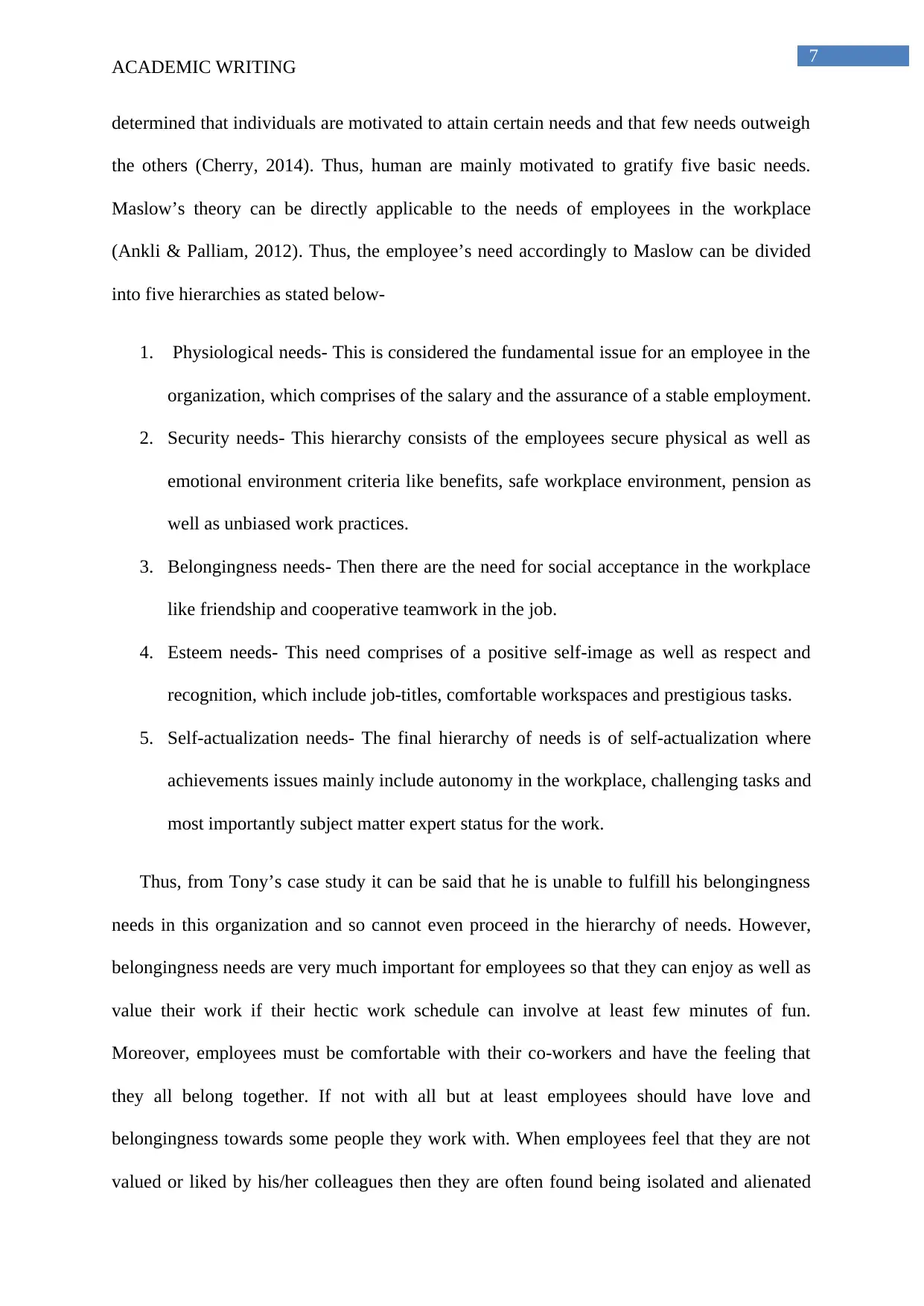
7
ACADEMIC WRITING
determined that individuals are motivated to attain certain needs and that few needs outweigh
the others (Cherry, 2014). Thus, human are mainly motivated to gratify five basic needs.
Maslow’s theory can be directly applicable to the needs of employees in the workplace
(Ankli & Palliam, 2012). Thus, the employee’s need accordingly to Maslow can be divided
into five hierarchies as stated below-
1. Physiological needs- This is considered the fundamental issue for an employee in the
organization, which comprises of the salary and the assurance of a stable employment.
2. Security needs- This hierarchy consists of the employees secure physical as well as
emotional environment criteria like benefits, safe workplace environment, pension as
well as unbiased work practices.
3. Belongingness needs- Then there are the need for social acceptance in the workplace
like friendship and cooperative teamwork in the job.
4. Esteem needs- This need comprises of a positive self-image as well as respect and
recognition, which include job-titles, comfortable workspaces and prestigious tasks.
5. Self-actualization needs- The final hierarchy of needs is of self-actualization where
achievements issues mainly include autonomy in the workplace, challenging tasks and
most importantly subject matter expert status for the work.
Thus, from Tony’s case study it can be said that he is unable to fulfill his belongingness
needs in this organization and so cannot even proceed in the hierarchy of needs. However,
belongingness needs are very much important for employees so that they can enjoy as well as
value their work if their hectic work schedule can involve at least few minutes of fun.
Moreover, employees must be comfortable with their co-workers and have the feeling that
they all belong together. If not with all but at least employees should have love and
belongingness towards some people they work with. When employees feel that they are not
valued or liked by his/her colleagues then they are often found being isolated and alienated
ACADEMIC WRITING
determined that individuals are motivated to attain certain needs and that few needs outweigh
the others (Cherry, 2014). Thus, human are mainly motivated to gratify five basic needs.
Maslow’s theory can be directly applicable to the needs of employees in the workplace
(Ankli & Palliam, 2012). Thus, the employee’s need accordingly to Maslow can be divided
into five hierarchies as stated below-
1. Physiological needs- This is considered the fundamental issue for an employee in the
organization, which comprises of the salary and the assurance of a stable employment.
2. Security needs- This hierarchy consists of the employees secure physical as well as
emotional environment criteria like benefits, safe workplace environment, pension as
well as unbiased work practices.
3. Belongingness needs- Then there are the need for social acceptance in the workplace
like friendship and cooperative teamwork in the job.
4. Esteem needs- This need comprises of a positive self-image as well as respect and
recognition, which include job-titles, comfortable workspaces and prestigious tasks.
5. Self-actualization needs- The final hierarchy of needs is of self-actualization where
achievements issues mainly include autonomy in the workplace, challenging tasks and
most importantly subject matter expert status for the work.
Thus, from Tony’s case study it can be said that he is unable to fulfill his belongingness
needs in this organization and so cannot even proceed in the hierarchy of needs. However,
belongingness needs are very much important for employees so that they can enjoy as well as
value their work if their hectic work schedule can involve at least few minutes of fun.
Moreover, employees must be comfortable with their co-workers and have the feeling that
they all belong together. If not with all but at least employees should have love and
belongingness towards some people they work with. When employees feel that they are not
valued or liked by his/her colleagues then they are often found being isolated and alienated
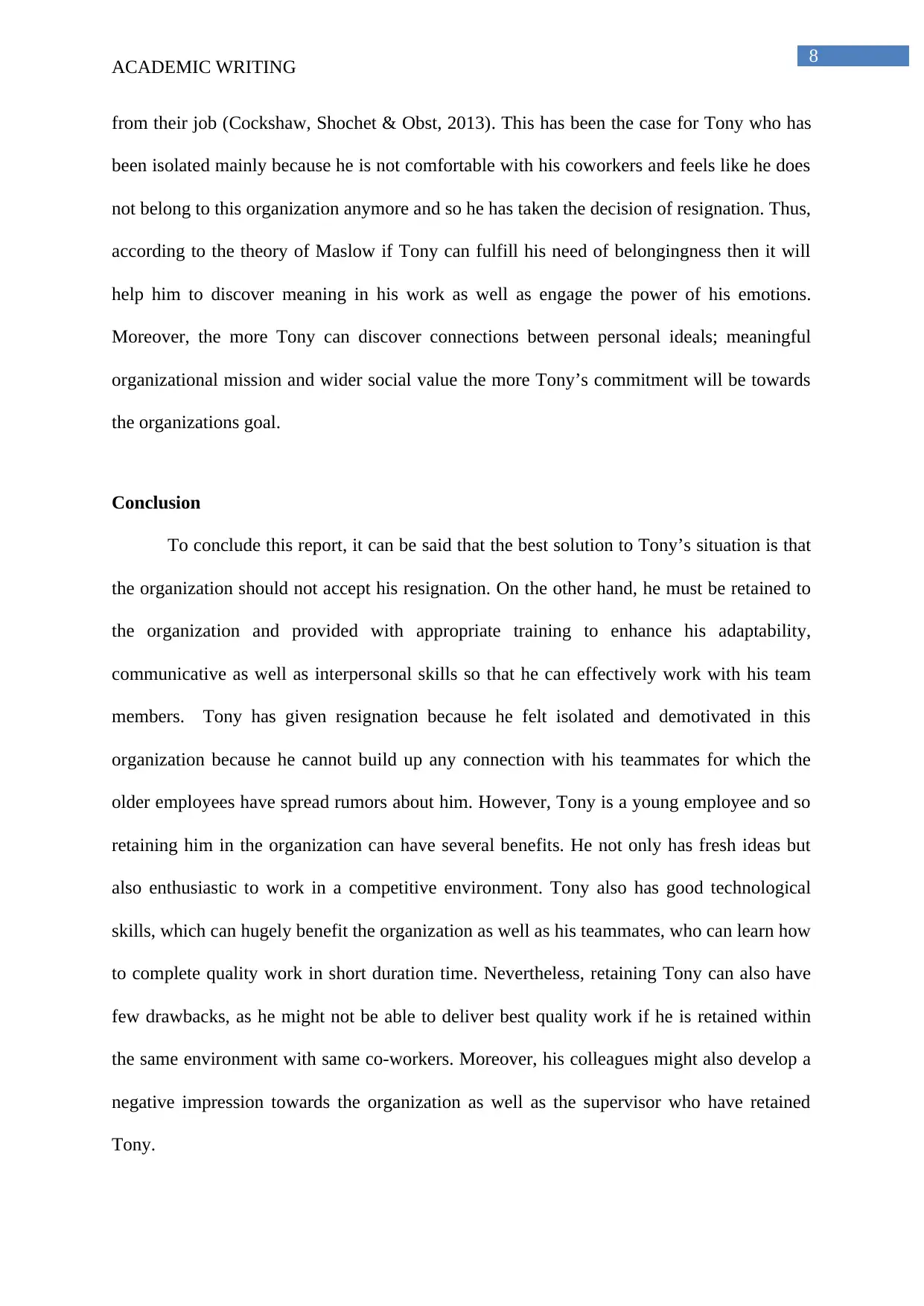
8
ACADEMIC WRITING
from their job (Cockshaw, Shochet & Obst, 2013). This has been the case for Tony who has
been isolated mainly because he is not comfortable with his coworkers and feels like he does
not belong to this organization anymore and so he has taken the decision of resignation. Thus,
according to the theory of Maslow if Tony can fulfill his need of belongingness then it will
help him to discover meaning in his work as well as engage the power of his emotions.
Moreover, the more Tony can discover connections between personal ideals; meaningful
organizational mission and wider social value the more Tony’s commitment will be towards
the organizations goal.
Conclusion
To conclude this report, it can be said that the best solution to Tony’s situation is that
the organization should not accept his resignation. On the other hand, he must be retained to
the organization and provided with appropriate training to enhance his adaptability,
communicative as well as interpersonal skills so that he can effectively work with his team
members. Tony has given resignation because he felt isolated and demotivated in this
organization because he cannot build up any connection with his teammates for which the
older employees have spread rumors about him. However, Tony is a young employee and so
retaining him in the organization can have several benefits. He not only has fresh ideas but
also enthusiastic to work in a competitive environment. Tony also has good technological
skills, which can hugely benefit the organization as well as his teammates, who can learn how
to complete quality work in short duration time. Nevertheless, retaining Tony can also have
few drawbacks, as he might not be able to deliver best quality work if he is retained within
the same environment with same co-workers. Moreover, his colleagues might also develop a
negative impression towards the organization as well as the supervisor who have retained
Tony.
ACADEMIC WRITING
from their job (Cockshaw, Shochet & Obst, 2013). This has been the case for Tony who has
been isolated mainly because he is not comfortable with his coworkers and feels like he does
not belong to this organization anymore and so he has taken the decision of resignation. Thus,
according to the theory of Maslow if Tony can fulfill his need of belongingness then it will
help him to discover meaning in his work as well as engage the power of his emotions.
Moreover, the more Tony can discover connections between personal ideals; meaningful
organizational mission and wider social value the more Tony’s commitment will be towards
the organizations goal.
Conclusion
To conclude this report, it can be said that the best solution to Tony’s situation is that
the organization should not accept his resignation. On the other hand, he must be retained to
the organization and provided with appropriate training to enhance his adaptability,
communicative as well as interpersonal skills so that he can effectively work with his team
members. Tony has given resignation because he felt isolated and demotivated in this
organization because he cannot build up any connection with his teammates for which the
older employees have spread rumors about him. However, Tony is a young employee and so
retaining him in the organization can have several benefits. He not only has fresh ideas but
also enthusiastic to work in a competitive environment. Tony also has good technological
skills, which can hugely benefit the organization as well as his teammates, who can learn how
to complete quality work in short duration time. Nevertheless, retaining Tony can also have
few drawbacks, as he might not be able to deliver best quality work if he is retained within
the same environment with same co-workers. Moreover, his colleagues might also develop a
negative impression towards the organization as well as the supervisor who have retained
Tony.
⊘ This is a preview!⊘
Do you want full access?
Subscribe today to unlock all pages.

Trusted by 1+ million students worldwide
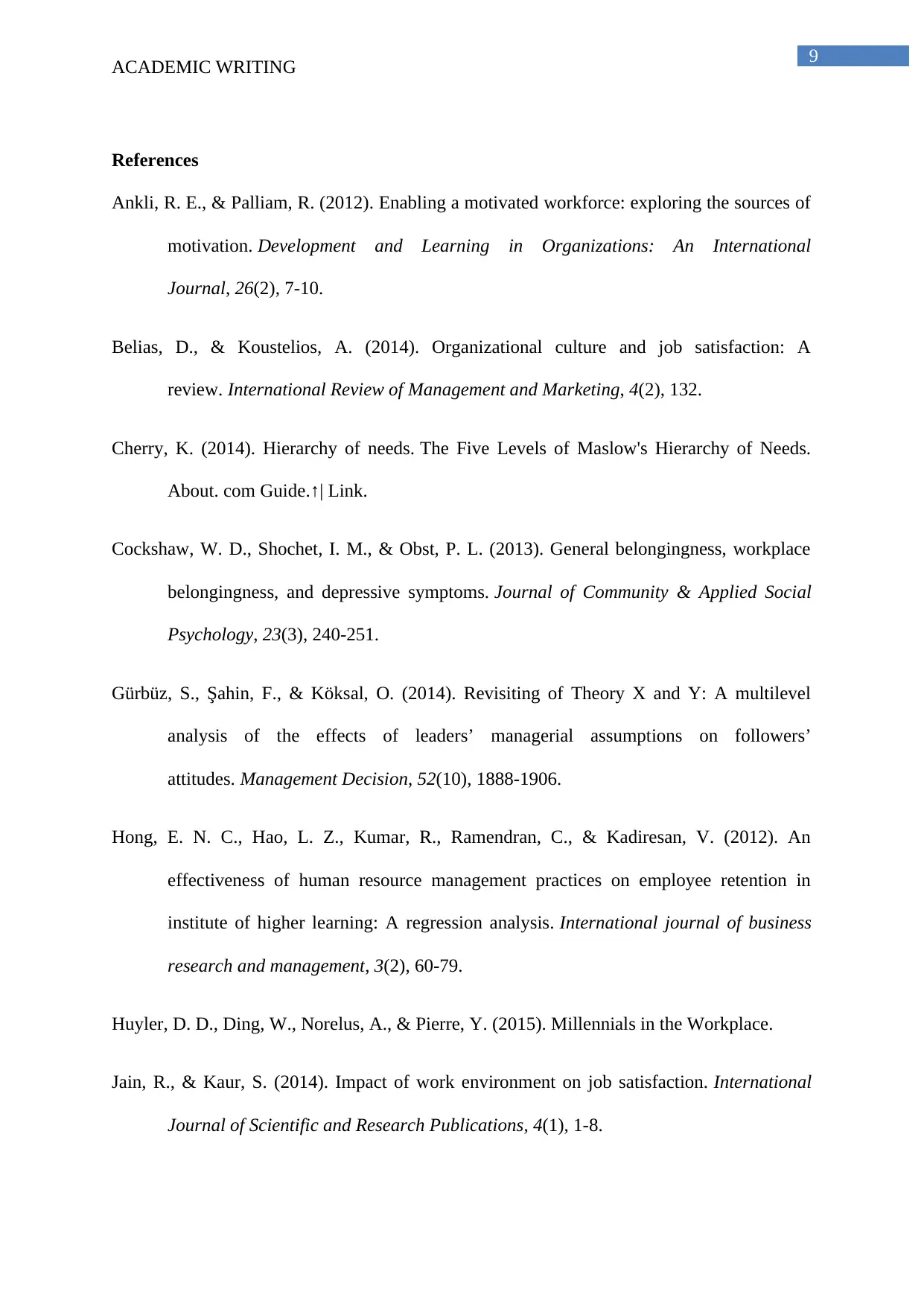
9
ACADEMIC WRITING
References
Ankli, R. E., & Palliam, R. (2012). Enabling a motivated workforce: exploring the sources of
motivation. Development and Learning in Organizations: An International
Journal, 26(2), 7-10.
Belias, D., & Koustelios, A. (2014). Organizational culture and job satisfaction: A
review. International Review of Management and Marketing, 4(2), 132.
Cherry, K. (2014). Hierarchy of needs. The Five Levels of Maslow's Hierarchy of Needs.
About. com Guide.↑| Link.
Cockshaw, W. D., Shochet, I. M., & Obst, P. L. (2013). General belongingness, workplace
belongingness, and depressive symptoms. Journal of Community & Applied Social
Psychology, 23(3), 240-251.
Gürbüz, S., Şahin, F., & Köksal, O. (2014). Revisiting of Theory X and Y: A multilevel
analysis of the effects of leaders’ managerial assumptions on followers’
attitudes. Management Decision, 52(10), 1888-1906.
Hong, E. N. C., Hao, L. Z., Kumar, R., Ramendran, C., & Kadiresan, V. (2012). An
effectiveness of human resource management practices on employee retention in
institute of higher learning: A regression analysis. International journal of business
research and management, 3(2), 60-79.
Huyler, D. D., Ding, W., Norelus, A., & Pierre, Y. (2015). Millennials in the Workplace.
Jain, R., & Kaur, S. (2014). Impact of work environment on job satisfaction. International
Journal of Scientific and Research Publications, 4(1), 1-8.
ACADEMIC WRITING
References
Ankli, R. E., & Palliam, R. (2012). Enabling a motivated workforce: exploring the sources of
motivation. Development and Learning in Organizations: An International
Journal, 26(2), 7-10.
Belias, D., & Koustelios, A. (2014). Organizational culture and job satisfaction: A
review. International Review of Management and Marketing, 4(2), 132.
Cherry, K. (2014). Hierarchy of needs. The Five Levels of Maslow's Hierarchy of Needs.
About. com Guide.↑| Link.
Cockshaw, W. D., Shochet, I. M., & Obst, P. L. (2013). General belongingness, workplace
belongingness, and depressive symptoms. Journal of Community & Applied Social
Psychology, 23(3), 240-251.
Gürbüz, S., Şahin, F., & Köksal, O. (2014). Revisiting of Theory X and Y: A multilevel
analysis of the effects of leaders’ managerial assumptions on followers’
attitudes. Management Decision, 52(10), 1888-1906.
Hong, E. N. C., Hao, L. Z., Kumar, R., Ramendran, C., & Kadiresan, V. (2012). An
effectiveness of human resource management practices on employee retention in
institute of higher learning: A regression analysis. International journal of business
research and management, 3(2), 60-79.
Huyler, D. D., Ding, W., Norelus, A., & Pierre, Y. (2015). Millennials in the Workplace.
Jain, R., & Kaur, S. (2014). Impact of work environment on job satisfaction. International
Journal of Scientific and Research Publications, 4(1), 1-8.
Paraphrase This Document
Need a fresh take? Get an instant paraphrase of this document with our AI Paraphraser
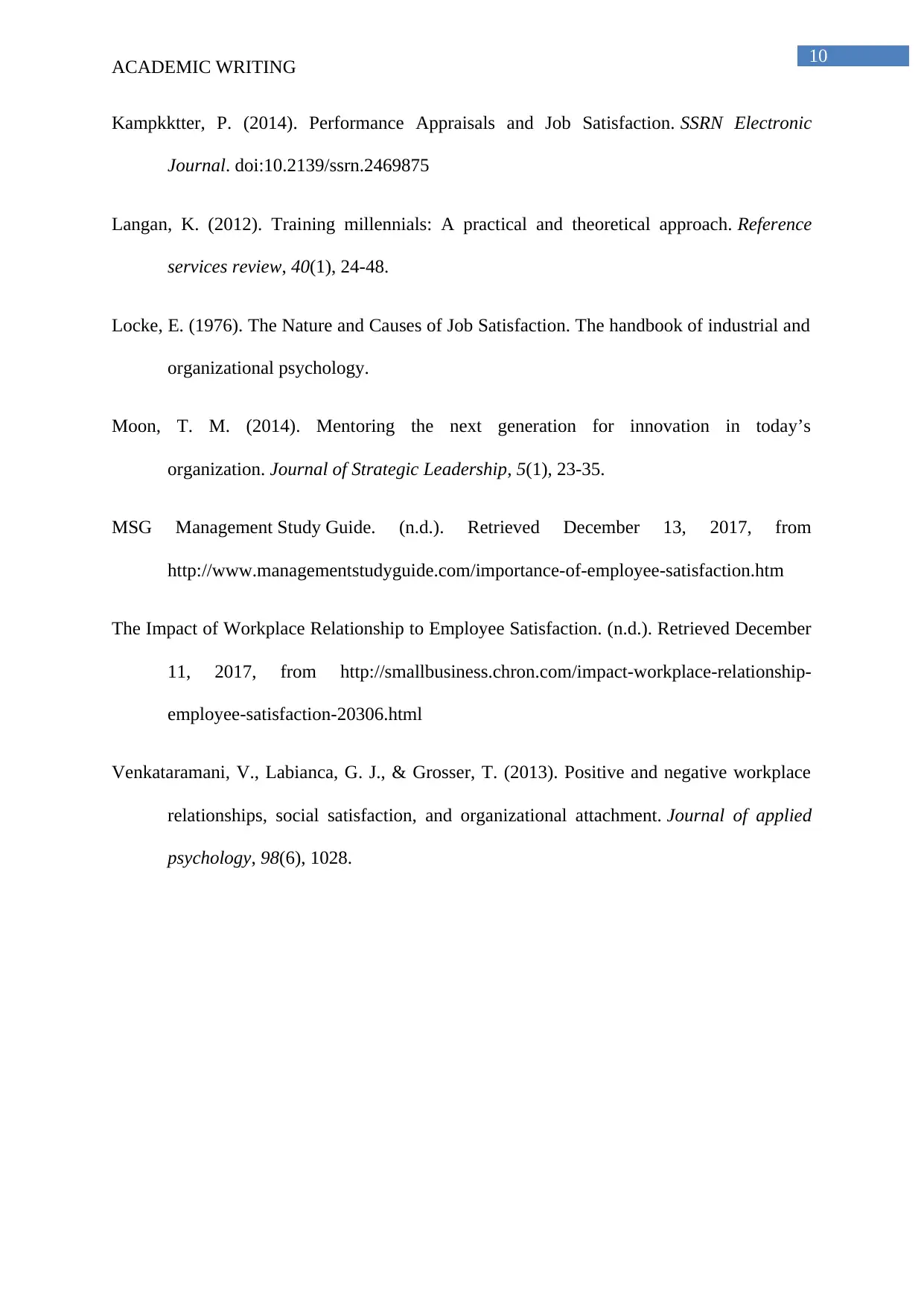
10
ACADEMIC WRITING
Kampkktter, P. (2014). Performance Appraisals and Job Satisfaction. SSRN Electronic
Journal. doi:10.2139/ssrn.2469875
Langan, K. (2012). Training millennials: A practical and theoretical approach. Reference
services review, 40(1), 24-48.
Locke, E. (1976). The Nature and Causes of Job Satisfaction. The handbook of industrial and
organizational psychology.
Moon, T. M. (2014). Mentoring the next generation for innovation in today’s
organization. Journal of Strategic Leadership, 5(1), 23-35.
MSG Management Study Guide. (n.d.). Retrieved December 13, 2017, from
http://www.managementstudyguide.com/importance-of-employee-satisfaction.htm
The Impact of Workplace Relationship to Employee Satisfaction. (n.d.). Retrieved December
11, 2017, from http://smallbusiness.chron.com/impact-workplace-relationship-
employee-satisfaction-20306.html
Venkataramani, V., Labianca, G. J., & Grosser, T. (2013). Positive and negative workplace
relationships, social satisfaction, and organizational attachment. Journal of applied
psychology, 98(6), 1028.
ACADEMIC WRITING
Kampkktter, P. (2014). Performance Appraisals and Job Satisfaction. SSRN Electronic
Journal. doi:10.2139/ssrn.2469875
Langan, K. (2012). Training millennials: A practical and theoretical approach. Reference
services review, 40(1), 24-48.
Locke, E. (1976). The Nature and Causes of Job Satisfaction. The handbook of industrial and
organizational psychology.
Moon, T. M. (2014). Mentoring the next generation for innovation in today’s
organization. Journal of Strategic Leadership, 5(1), 23-35.
MSG Management Study Guide. (n.d.). Retrieved December 13, 2017, from
http://www.managementstudyguide.com/importance-of-employee-satisfaction.htm
The Impact of Workplace Relationship to Employee Satisfaction. (n.d.). Retrieved December
11, 2017, from http://smallbusiness.chron.com/impact-workplace-relationship-
employee-satisfaction-20306.html
Venkataramani, V., Labianca, G. J., & Grosser, T. (2013). Positive and negative workplace
relationships, social satisfaction, and organizational attachment. Journal of applied
psychology, 98(6), 1028.
1 out of 11
Related Documents
Your All-in-One AI-Powered Toolkit for Academic Success.
+13062052269
info@desklib.com
Available 24*7 on WhatsApp / Email
![[object Object]](/_next/static/media/star-bottom.7253800d.svg)
Unlock your academic potential
Copyright © 2020–2025 A2Z Services. All Rights Reserved. Developed and managed by ZUCOL.





